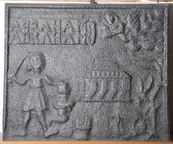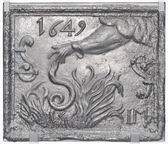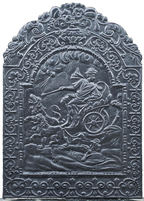-
669
Description: Rectangular; reversed cavetto-moulded edge on top and sides; pictorial scene depicting Abraham about to sacrifice Isaac; Abraham is on the left, holding the top of Isaac’s head with his left hand, his right hand holding a sword; in the middle stands a pyre; above and to the right an angel emerges from the clouds, while below a ram stands beside a bush; the inscription is above and to the left.
Notes: The scene is drawn from Genesis 22: 11; And the angel of the Lord called unto him out of heaven, and said, “Abraham, Abraham”: and he said, “Here am I”. The subject and the naïve figuration is similar to a fireback incorporating two other Old Testament scenes (no. 94), and may be the work of the same pattern maker.
Inscription: ABRAHAM ABRAHAM [Genesis 22: 11]
- Decoration tags:
- rectangular (shape)
- reversed cavetto (edging)
- whole carved pattern
- pictorial
- biblical
- architectural
- text
- humans
- plants
Manufactured: in the early- to mid-17th century possibly at Brede Furnace in the Weald area of England.
Current location: Rottingdean Grange, The Green, Rottingdean, East Sussex, England.
(part of the Brighton Museum museum group)
- Attached to series:
- Brede group
- Old Testament & Apocrypha firebacks
- Abraham & Isaac firebacks
-
904
Description: Arched rectangular shaped central panel with five-bead and open pellet edging; pictorial: regal figure in his chariot drawn by two horses, a sceptre in his right hand; above, a putto descends from swagged curtains and a pair of tassels; below is a landscape with a cornucopia; arched rectangular shaped border with fillet edging, a scallop shell top centre with symmetrical arrangement of ivy and acanthus leaves and tendrils; the initial, N, in a cartouche bottom centre, between symmetrical oak fronds, leaves and acorns; above is a symmetrical design of scrolled floral tendrils terminating in sea monsters.
Notes: Very similar in design and execution to firebacks of the SHR and EB series, suggesting designs emanating from the same source and with a similar inspiration. The figure in the chariot may be an allegory of the Sun. Apollo is traditionally drawn by horses.
Copies of this fireback are known.
Inscription: N
- Decoration tags:
- 'Dutch' (shape)
- fillet (edging)
- whole carved pattern
- allegorical
- animals
- humans
- plants
- objects
Manufactured: in the early-18th century in England.
Current location: not known.
- Attached to series:
- N series
- British 'Dutch' style firebacks
-
751
Description: Rectangular, cavetto moulded edging; Stuart royal shield, garter, supporters and crown.
Notes: One clear vertical plank line indicate that the pattern for this fireback was formed of a series of boards probably secured by horizontal battens on the rear.
Copies of this fireback are known.
Inscription: HONI SOIT QVI MAL Y PENSE
Arms: English Stuart royal
- Decoration tags:
- rectangular (shape)
- cavetto (edging)
- whole carved pattern
- planklines
- armorial
- royal
- text
Manufactured: in the mid- to late-17th century in England.
Current location: Victoria & Albert Museum, Cromwell Road, Kensington & Chelsea, Greater London, England.
Museum number: 432.1896 (part of the Victoria & Albert Museum museum group)
- Attached to series:
- Stuart royal armorial firebacks
-
769
Description: Rectangular; cavetto-moulded edge; a snake rises from a fire and bites the middle finger of the hand of a sleeved left arm that descends from a top right corner cloud; left and right, ‘S’ scrolls appear strapped to the edge of the fireback; the date, top left of centre; initials, bottom right corner.
Notes: An illustration of the New Testament episode (Acts 28: 3) when St Paul, shipwrecked in the island of Malta, was putting sticks on a fire and a viper bit him. The distinctive shape of the ‘1’ in the date and the initials, ‘IM’, together with the ‘S’ scrolls, parallel such features in other firebacks. The design is an adaptation of an illustration in 'Devises Heroiques' by Claudius Paradin (1557) which was translated into English by Geoffrey Whitney as 'The Book of Emblemes' (1586).
Copies of this fireback are known.
Inscription: 1649 / IM
- Decoration tags:
- rectangular (shape)
- cavetto (edging)
- whole carved pattern
- biblical
- text
- animals
- humans
Manufactured: in 1649 possibly at Brede Furnace in the Weald area of England.
Current location: Victoria & Albert Museum, Cromwell Road, Kensington & Chelsea, Greater London, England.
Museum number: M.119-1984 (part of the Victoria & Albert Museum museum group)
Citation: Hamling, T., 2010, Decorating the 'Godly' Household (New Haven, Yale), pp. 251-2.
- Attached to series:
- IM series
- Hooked '1' series
- New Testament firebacks
- Brede group
-
626
Description: Arched rectangular central panel; bead-and-pellet edging; pictorial scene of a male figure seated in a chariot, his left arm resting on the side of the chariot, his right hand holding a sceptre at arm’s length, the chariot drawn by two lions across a ground with small bushes; clouds above with the personification of the wind blowing to the left; arched rectangular border with fillet edging; repeated, linked scroll-work on all sides; on top a vase of fruit between two mirrored serpents. A recasting.
Notes: Similar to other designs incorporating figures in chariots, though not from the same series; a recasting has the date, 1702, superimposed.
Copies of this fireback are known.
- Decoration tags:
- 'Dutch' (shape)
- fillet (edging)
- whole carved pattern
- pictorial
- mythological
- text
- animals
- humans
- objects
Manufactured: in the late-17th to early-18th century in England.
Current location: Westland Ltd, St Leonards Church, Leonard Street, Shoreditch, London, England.
- Attached to series:
- British 'Dutch' style firebacks




